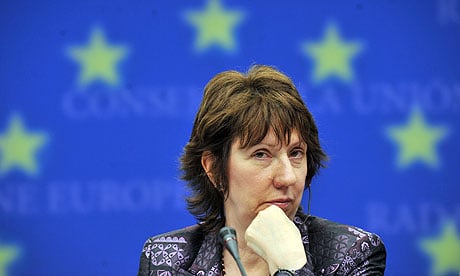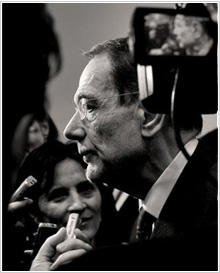
Photograph: Georges Gobet/AFP/Getty Images
Several weeks ago, HR Ashton, EU foreign policy chief, announced that she will be done at the end of her mandate in 2014. In an interview – posted below – orchestrated by Steven Erlanger, Paris Bureau Chief of the New York Times, and organized by the German Marshall Fund, Cathy Ashton finally opened up and talked about her job and its challenges. She even reflected on her legacy. This interview touches on very important issues such as the creation of the position of HR after the Treaty of Lisbon; intervention in Libya; lifting the arm embargo to Syria; Iran talks; the EU relative failures in Libya and Mali; and the context of the creation of EEAS. This discussion is a must-see as it is in some degree an intimate discussion with a misunderstood, unknown, and too some extent controversial European leader.
Her predecessor, Javier Solana, was a master at shaping a narrative through its heavy presence in the press, conferences

Council of the EU
and so on. Prior to his appointment at the head of NATO, Javier Solana served in the Spanish government of Felipe González from 1982 to 1995. His last mandate as the Minister of Foreign Affairs of Spain from 1992 to 1995 exposed him on the international arena, which contributed to his appointment at the head of NATO from 1995 to 1999. Many argue that Solana was a diplomatic and strategic politician allowing to become the only remaining politician from the original cabinet of González after 13 years. His presence at the forefront of international affairs was central in shaping a European narrative. His main theme developed and promoted throughout his two mandates was to create a multi-dimensional global Europe with a diplomatic, military, political and institutional dimension.
Under HR Ashton, her approach and strategy have been very discret and even reserved. She has been avoiding talking to the press directly after closed- and open- doors meetings. However, this type of interview with the GMF is very positive and plays in favor of Ashton as she can finally formulate her vision of ‘her’ global Europe. She has been criticized for not playing the media game. Solana was excellent at promoting his global Europe; Ashton has failed short of it. Too some extent, HR Ashton has never taken full possession of her position, which was not the case of Solana.
Back to the interview – below – the moderator asked a key question reflecting on the last two engagements in Libya and Mali: “In Mali, even the French has given up on using EU ressources for their military goals. What is left, how can the EU have a serious pretention to play a role in international security, when even its key members are not using it?” The question is legitimate; her answer was too technocratic. She argues, not surprisingly, that the EU is already very involved in the region of the Sahel with missions in Niger, EUTM, and has even drafted a strategy for the region. Unfortunately, she never tried to tackle the problem of a weaker EU in terms of defense.
Another interesting question raised by Erlanger was: “Some people would have said that your job is impossible, and it takes a lot of patience obviously. What would you say are the biggest constraints you being able to do the job you really would like to do.” Ashton’s reply was right on again, as she underlined the financial crisis – austerity measures across Europe – as a major limitation to the development of the EEAS to its full potential. Not only the EU budget is tighter and Europe’s neighborhoods are so volatile. She describes her job as “trying to fly a plane while building the wings at the same time.” This may be the major difference between Solana and Ashton. Solana took the lead of the EU foreign policy in times of growth and stability and supports by the EU Member States. Ashton, instead, is facing a vicious crisis and strong domestic oppositions to fostering the integration of the Union.
During the Q&A, a member of the audience asked HR Ashton to reflect on her legacy. She replied without any doubt that her “legacy would be the foundation of the External Action Service and the beginning of what its role can be.” Many experts have certainly argued that HR Ashton has proven to be more of an administration than a diplomat.
This video is very positive as it finally shows the face of European foreign policy to wider audience. Part of the job of a politician ought to be half policy-making and half marketing. Ashton has not done enough of marketing. Even though she did a convincing job of public relations, there is a sense that she is rather uncomfortable seating down and discussing about her job. In concluding the interview, Steven Erlanger, asked her “you seem shy of the press. You don’t give briefings, you don’t give off the record briefings. Why? What constrains you from being more of an advocate?” To be honest, HR Ashton dodged the bullet once again. As it was the case for Solana or even Cooper, the press always played an important role in order to construct a narrative around their policies and even their diplomacy. This has certainly been missing from Ashton’s arsenal.